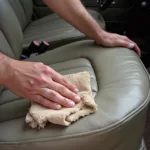Using Bondo car filler to repair exterior wood rot on window frames might seem like a quick fix, but it’s crucial to understand the implications before you begin. While Bondo can effectively fill gaps and create a smooth surface, it’s not a long-term solution for wood rot.
Understanding the Limitations of Bondo for Wood Rot Repair
Bondo, a polyester resin filler, excels at repairing dents and imperfections on metal car bodies. However, wood, unlike metal, is porous and susceptible to moisture absorption. While Bondo can temporarily fill the void left by rot, it doesn’t address the underlying moisture issue.
Why Bondo Isn’t a Permanent Solution
Applying Bondo to a rotted window frame traps moisture beneath the surface. This trapped moisture accelerates the decaying process, leading to further damage beneath the Bondo layer. Eventually, the Bondo will detach, requiring even more extensive repairs.
Addressing Wood Rot: The Correct Approach
Effectively repairing wood rot on your window frames involves a multi-step process:
-
Assess the Damage: Determine the extent of the rot. If the damage is minimal, you can proceed with repair. However, severe rot necessitates complete window frame replacement.
-
Remove the Rot: Thoroughly remove all decayed wood using a chisel or a rotary tool. It’s crucial to eliminate all affected areas to prevent further decay.
-
Treat with Wood Hardener: Apply a wood hardener to the exposed wood. This step strengthens the remaining wood and creates a stable surface for patching.
-
Patch the Area: Use a two-part wood filler or epoxy to fill the cavity. These materials bond better with wood and offer better moisture resistance than Bondo.
-
Sand and Prime: Once the filler dries, sand the area smooth and prime it before painting. This step ensures a smooth and even surface for the final paint application.
When to Consider Bondo
While not a permanent fix for wood rot, Bondo can be suitable for minor imperfections after addressing the root cause. For instance, if you have a small area with minimal rot, removing the decayed wood, treating it with wood hardener, and then using Bondo as a final filler before painting can be an acceptable solution.
Consult a Professional
When in doubt, consult a professional contractor specializing in window repair or restoration. They can assess the severity of the damage and recommend the most appropriate course of action. Remember, addressing wood rot promptly and correctly ensures the longevity and structural integrity of your windows.


